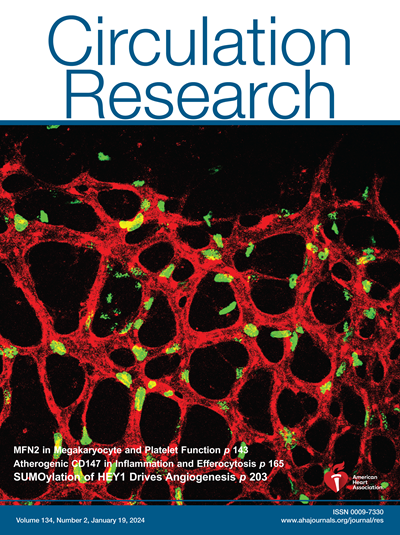GP130 Antagonism Enhances Porcine RV Function.
IF 16.2
1区 医学
Q1 CARDIAC & CARDIOVASCULAR SYSTEMS
引用次数: 0
Abstract
BACKGROUND Right ventricular (RV) dysfunction is a risk factor for death in multiple cardiovascular diseases, but RV-enhancing therapies are lacking. Inhibition of GP130 (glycoprotein-130) signaling with the small molecule SC144 improves RV function in rodent RV dysfunction via anti-inflammatory and metabolic mechanisms. However, SC144's efficacy and molecular effects in a translational large animal model of RV dysfunction are unknown. METHODS Four-week-old castrated male pigs underwent pulmonary artery banding (PAB). After 3 weeks, PAB pigs were randomized into 2 groups (daily injections of SC144 [2.2 mg/kg, PAB-SC144, n=5] or vehicle [PAB-Veh, n=5] for 3 weeks). Five age-matched pigs served as controls. Cardiac magnetic resonance imaging quantified RV size/function. Right heart catheterization evaluated hemodynamics. Single-nucleus RNA sequencing delineated cell-type-specific changes between experimental groups. Electron microscopy evaluated RV mitochondrial morphology. Phosphoproteomics identified dysregulated RV kinases. Lipidomics and metabolomics quantified lipid species and metabolites in RV tissue and serum. Quantitative proteomics examined RV mitochondrial protein regulation. Confocal microscopy evaluated alterations in cardiomyocyte size, macrophage abundances, capillary density, and pericyte/endothelial cell localization patterns. RESULTS SC144 significantly improved RV ejection fraction (control: 60±4%; PAB-Veh: 22±10%; PAB-SC144: 37±6%) without altering RV afterload. Single-nucleus RNA sequencing demonstrated that PAB-Veh pigs had lower cardiomyocyte and higher macrophage/lymphocyte/pericyte/endothelial cell abundances as compared with control, and many of these changes were blunted by SC144. Immunohistochemistry validated the reduction in RV macrophage infiltration by SC144. Both transcriptomics and proteomics approaches demonstrated that SC144 combatted the downregulation of cardiomyocyte metabolic genes/proteins induced by PAB. Kinome enrichment analysis suggested SC144 counteracted RV mTORC1 (mammalian target of rapamycin complex 1) activation. Correspondingly, SC144 rebalanced the RV autophagy pathway proteins and improved mitochondrial morphology. Integrated lipidomics, metabolomics, and proteomics analyses revealed that SC144 restored fatty acid metabolism. Finally, CellChat analysis, cardiomyocyte RNAseq analysis, and histological examination suggested SC144 rebalanced pericyte-endothelial cell interactions and blunted cardiomyocyte HIF1 (hypoxia-induced factor 1) activation. CONCLUSIONS GP130 antagonism blunts RV immune cell infiltration, reduces proinflammatory gene programs in macrophages and lymphocytes, rebalances autophagy, and preserves fatty acid metabolism in cardiomyocytes, and restores endothelial cell and pericyte homeostasis to mitigate cardiomyocyte hypoxia and ultimately augments RV function.GP130拮抗增强猪RV功能
背景:右心室功能障碍是多种心血管疾病患者死亡的危险因素,但右心室功能增强疗法缺乏。用小分子SC144抑制GP130(糖蛋白-130)信号通过抗炎和代谢机制改善啮齿动物RV功能障碍中的RV功能。然而,SC144在RV功能障碍的翻译大动物模型中的功效和分子效应尚不清楚。方法4周龄去势公猪行肺动脉绑扎术(PAB)。3周后,将PAB猪随机分为2组(每日注射SC144 [2.2 mg/kg, PAB-SC144, n=5]或对照剂[PAB- veh, n=5],持续3周)。5只年龄相仿的猪作为对照。心脏磁共振成像量化右心室大小/功能。右心导管检查血流动力学。单核RNA测序描绘了实验组之间细胞类型特异性的变化。电镜观察RV线粒体形态。磷酸化蛋白质组学鉴定了失调的RV激酶。脂质组学和代谢组学量化了RV组织和血清中的脂质种类和代谢物。定量蛋白质组学检测RV线粒体蛋白调控。共聚焦显微镜评估心肌细胞大小、巨噬细胞丰度、毛细血管密度和周细胞/内皮细胞定位模式的改变。结果sc144在不改变右心室后负荷的情况下显著提高右心室射血分数(对照组:60±4%;ab - veh: 22±10%;ab - sc144: 37±6%)。单核RNA测序结果显示,与对照组相比,PAB-Veh猪心肌细胞丰度较低,巨噬细胞/淋巴细胞/周细胞/内皮细胞丰度较高,SC144可以减弱这些变化。免疫组织化学证实SC144可减少RV巨噬细胞浸润。转录组学和蛋白质组学方法都表明,SC144可以对抗PAB诱导的心肌细胞代谢基因/蛋白的下调。Kinome富集分析表明SC144抵消了RV mTORC1(哺乳动物雷帕霉素复合物1靶点)的激活。相应地,SC144重新平衡了RV自噬途径蛋白,改善了线粒体形态。综合脂质组学、代谢组学和蛋白质组学分析显示,SC144恢复了脂肪酸代谢。最后,CellChat分析、心肌细胞RNAseq分析和组织学检查表明,SC144重新平衡了周细胞-内皮细胞的相互作用,减弱了心肌细胞HIF1(缺氧诱导因子1)的激活。结论sgp130拮抗剂抑制RV免疫细胞的浸润,降低巨噬细胞和淋巴细胞的促炎基因程序,重新平衡自噬,保持心肌细胞的脂肪酸代谢,恢复内皮细胞和周细胞的稳态,减轻心肌细胞缺氧,最终增强RV功能。
本文章由计算机程序翻译,如有差异,请以英文原文为准。
求助全文
约1分钟内获得全文
求助全文
来源期刊

Circulation research
医学-外周血管病
CiteScore
29.60
自引率
2.00%
发文量
535
审稿时长
3-6 weeks
期刊介绍:
Circulation Research is a peer-reviewed journal that serves as a forum for the highest quality research in basic cardiovascular biology. The journal publishes studies that utilize state-of-the-art approaches to investigate mechanisms of human disease, as well as translational and clinical research that provide fundamental insights into the basis of disease and the mechanism of therapies.
Circulation Research has a broad audience that includes clinical and academic cardiologists, basic cardiovascular scientists, physiologists, cellular and molecular biologists, and cardiovascular pharmacologists. The journal aims to advance the understanding of cardiovascular biology and disease by disseminating cutting-edge research to these diverse communities.
In terms of indexing, Circulation Research is included in several prominent scientific databases, including BIOSIS, CAB Abstracts, Chemical Abstracts, Current Contents, EMBASE, and MEDLINE. This ensures that the journal's articles are easily discoverable and accessible to researchers in the field.
Overall, Circulation Research is a reputable publication that attracts high-quality research and provides a platform for the dissemination of important findings in basic cardiovascular biology and its translational and clinical applications.
 求助内容:
求助内容: 应助结果提醒方式:
应助结果提醒方式:


